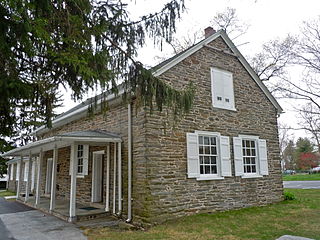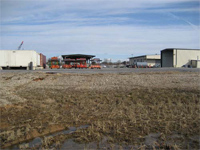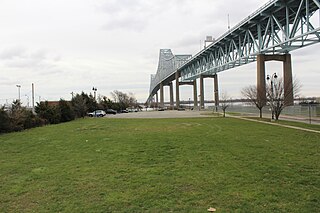
Superfund is a United States federal environmental remediation program established by the Comprehensive Environmental Response, Compensation, and Liability Act of 1980 (CERCLA). The program is administered by the Environmental Protection Agency (EPA). The program is designed to investigate and clean up sites contaminated with hazardous substances. Sites managed under this program are referred to as "Superfund" sites. There are 40,000 federal Superfund sites across the country, and approximately 1,300 of those sites have been listed on the National Priorities List (NPL). Sites on the NPL are considered the most highly contaminated and undergo longer-term remedial investigation and remedial action (cleanups).

The Rocky Mountain Arsenal was a United States chemical weapons manufacturing center located in the Denver Metropolitan Area in Commerce City, Colorado. The site was completed December 1942, operated by the United States Army throughout the later 20th century and was controversial among local residents until its closure in 1992.

Havertown is a residential suburban unincorporated community in Haverford Township, Pennsylvania, United States. It is located approximately 9 miles west of the center of Philadelphia. Havertown's ZIP Code is 19083 and "Havertown" is a postal address. The name "Havertown" was coined by the U.S. Post Office and came into use on January 1, 1946. Before then, each constituent community was known by its local name: Bon Air, Brookline, Penfield, Beechwood, Llanerch, Manoa, Oakmont, Coopertown, and Ardmore. Under William Penn's land divisions these communities were part of the Welsh Tract and comprised the area known as Harford, a Welsh contraction of Haverford.

Pacific Creosoting Company was a company founded on Bainbridge Island that treated logs with creosote as a preservative.

Naylors Run is a 4.6-mile-long (7.4 km) tributary of Cobbs Creek in Haverford and Upper Darby Township, Pennsylvania, United States.

The American Creosote Works Superfund site is an inactive wood-treating facility in Pensacola, Florida. The 18-acre site is located about 600 yards north of the confluence of Bayou Chico and Pensacola Bay at 701 S "J" Street. The Superfund program of the United States Environmental Protection Agency (EPA) is responsible for cleaning up the nation's most contaminated land and responding to environmental emergencies, oil spills, and natural disasters.

Wade Dump was a rubber recycling facility and illegal industrial waste storage and disposal facility in Chester, Pennsylvania. It was located at 1 Flower Street on the western bank of the Delaware River just north of the Commodore Barry Bridge.
The Escambia Wood Treating Company (ETC) site is located at 3910 Palafox Highway, northeast of the intersection of Fairfield Drive in Pensacola, Florida, and is in a mixed industrial, commercial, and residential area. The site includes the 26-acre property of the former wood preserving facility and over 60 acres of nearby neighborhoods. The facility was in operation from 1942 until 1982, then abandoned by the owner in 1991. During its operation, ETC treated utility poles, foundation pilings, and lumber with creosote and pentachlorophenol. Production byproducts were dumped into on-site, unlined containment pits where they seeped into the surrounding soil and groundwater. Escambia Wood Treating Company

The BoRit Asbestos Superfund site is a 32-acre (13 ha) waste dump and reservoir in Ambler, Upper Dublin Township and Whitpain Township, Pennsylvania that was contaminated with 1.5 million cubic yards of asbestos containing material due to the waste disposal practices of the Keasbey and Mattison (K&M) Company and Turner and Newall from 1897 to 1962. The site is named BoRit after Bob Rittenhouse, one of the recent owners of the site.

The Koppers Co., Inc. (KCI) Superfund Site is one of three Superfund sites in Oroville, California, along with Louisiana Pacific Sawmill and Western Pacific Railyard. The KCI Superfund Site is a 200-acre site which served as a wood treatment plant for 50 years. Wood was treated with many chemicals to prevent wood deterioration. The accumulation of these chemicals from spills, fires, and uses has caused this site to be contaminated with the hazardous waste material. Due to soil and groundwater contamination, the site was placed on the National Priorities List in 1984 for remedial action plans to clean up the site to protect surrounding residential areas concerning environmental and human health risks.
The Ashland/Northern States Power Lakefront Superfund site is a contaminated region of the Wisconsin shoreline of Lake Superior that is being studied for remediation by Northern States Power Wisconsin (NSPW), as well as the Environmental Protection Agency (EPA), the Wisconsin Department of Natural Resources (WDNR). This site has held a manufactured gas plant from 1845 to 1947, as well as lumber manufacturing and treatment mills for four decades at the start of the 20th century, railcar loading facilities, and a municipal landfill. Additionally, a wastewater treatment plant is located on the premises, but is not in operation. Contamination of the site is currently believed to have been caused by all the parties mentioned above, or former owners of the property whose companies are no longer in business. The area is listed as a Superfund site by the EPA under the Comprehensive Environmental Response, Compensation, and Liability Act (CERCLA). Releases of hazardous substances occurred onshore and migrated into sediment in Chequamagon Bay on Lake Superior.
The A.O. Polymer manufacturing site is located in Sparta Township, New Jersey. This facility created special polymers, plastics, and resins. It was also used for reclaiming spent solvents. The facility's poor waste handling led to serious contamination of the ground. It also contaminated the water in the ground with volatile organic compounds. The site has been a threat to the Allentown aquifer, which provides drinking water to over 5,000 people. Initial clean ups started with getting rid of old drums and contaminants from their original disposal area. The company took them and decided to dispose of them elsewhere, thus not fixing the problem. Primary cleanups of the site were ongoing as of 2008. The EPA has been using water pumps to remove contaminants from the water in the ground. A soil extraction system has been put at their disposal to remove harmful contamination within the soil as well. All wells in the affected areas have been closed.
Emmell's Septic Landfill (ESL) is located at 128 Zurich Ave, Galloway Township, New Jersey and takes up about 38 acres of space. The landfill was in operation from 1967 until 1979. ESL disposed of liquid and solid waste including many chemicals such as volatile organic compounds (VOCs), Polychlorinated Biphenyls (PCBs), Trichloroethene and Vinyl chloride which all had their own effect on the environment and community. These chemicals affected the groundwater required millions of dollars to reconstruct the groundwater pathways and provide clean water to residents. The landfill holds a Hazardous Ranking Score of a 50/100, qualifying for the Superfund National Priority List. In August 1999, the state acknowledged the site's contamination and held town meetings and provided research upon the site such as groundwater samples. In July 1997, a sitewide investigation was called upon by the United States Environmental Protection Agency. In total the clean up was estimated to cost $5 million to fund this superfund site, and a grant of $3.9 million was given by the Federal Government under the Recovery Act Funding (Previti). Today, the project is still ongoing however, greatly improved since the landfill was discovered.
Bog Creek Farm, located in Howell Township, New Jersey, is a designated Environmental Protection Agency (EPA) Superfund site. Lying on 12 acres of land, Bog Creek Farm is home to several hazardous and life-threatening contamination beginning in 1973 and continuing for a year. Over a decade later, actions began to take place to clean and restore the contaminated soil and water. Bog Creek Farm is situated near several other farms that house horses, growing crops and flowers, and livestock. Less than a mile down the road lies Allaire State Park, a park used by golfers, hunters, and fisherman.
The CPS Madison Industries Superfund Site is located in Old Bridge, New Jersey. Since 1967, site operators had improperly handed high-risk substances by expelling them into public sewer systems throughout the township. Established in 1962, CPS Madison Industries, located in Middlesex County, New Jersey, has remained a large competitor in the copper and zinc industry producing compounds primarily for food additives, fertilizers, and pharmaceuticals. CPS Madison Industries was declared to be a superfund site as of September 8, 1983, due to its improper handlings of Volatile Organic Compounds, and has since been undergoing groundwater pump and treatment systems since 1991.
Brook Industrial Park (BIP) is an industrial area occupying 4.5 acres of the Borough of Bound Brook, New Jersey, in the United States of America. It is located on the northern bank of the Raritan River. Industrial, chemical and pesticide operations began in 1971 and eventually lead to the contamination of groundwater and exposure of workers to harmful dioxins. Throughout 1980 to 1988 the United States Environmental Protection Agency (EPA) and the New Jersey Department of Environmental Protection (NJDEP) conducted studies to determine if there were any threats being posed on the workers, community or environment by the BIP companies in their disposal of processed and stored chemicals.
The Zschiegner Refining Company (ZRC) was located in Howell, New Jersey, and operated as a metal refining facility. Some of their operations included stripping the chemicals off of precious metals from watch bands, photographic film, and electrical components. In 1992, the United States Environmental Protection Agency (EPA) discovered that 3,000 chemicals had contaminated the soil, surface water, and groundwater. These areas were contaminated due to discharge of waste to the ground surface, the movement of waste and contamination downhill from the site building, along with surface water runoff. When the EPA investigated the site and found the chemicals in the groundwater and soil, they shut down the company that same year in 1992. In that area, the environment and people were affected, especially the workers in the facility. After a Hazard Ranking System report was conducted by the EPA, the site was placed on the National Priorities List in March 1998. In 2008, the cleanup was completed, but groundwater and wetland is still being monitored.
The Orange Valley Regional Groundwater Superfund site is a group of wells in Orange and West Orange, two municipalities in Essex County, New Jersey, United States. The groundwater in the public wells are contaminated with the hazardous chemicals of Trichloroethylene (TCE), Dichloroethene (DCE), Tetrachloroethylene (Perchloroethene), 1,1-Dichloroethene (1,1-DCE), and 1,2-Dichloroethene (1,2-DCE). These chemicals pose a huge risk to the towns nearby population, as the wells are a source of public drinking water. In March 2012, the site was added to the National Priorities List (NPL) of the United States Environmental Protection Agency (EPA) Superfund site list.
Price Landfill is a 26-acre site located in Pleasantville, Egg Harbor Township, Atlantic County, New Jersey. Price Landfill is also known as Price Sanitary Landfill, Prices Pit, Price Landfill No.1 and Price Chemical Dump. The United States Environmental Protection Agency (USEPA) added Price Landfill to the Superfund National Priorities List on September 20, 1983 because of the hazardous chemicals found on the site and in the groundwater. The site was originally owned by Mr. Charles Price and was used to mine sand and gravel, which was shut down in 1968. The site was then turned into a private landfill in 1969 and then a commercial solid waste landfill in 1971. At this point the landfill was used to dispose of liquid waste by companies, specifically Atlantic City Electric Company. The liquid waste consisted of industrial chemicals, oils and greases/sludges, septic tank and sewer wastes, which were disposed on the site for 8 years, ending altogether in 1976, but in the meantime, having contaminated the groundwater, soil, air, and nearby creeks, specifically Absecon Creek. Chemicals dumped on the site are believed to be 1,2-Dichloroethane, arsenic, benzene, chloroform, lead, and vinyl chloride, all of which contaminated the groundwater, soil, air, and nearby creeks. The USEPA originally got involved in 1982 by beginning to correct the damage. Currently the USEPA states that they are continuing to monitor and treat the groundwater and land, and that hazards to humans are controlled.
The Garfield Groundwater Contamination site is a Superfund site located in Garfield, New Jersey. The site was formally occupied by E.C Electroplating, an electroplating company that used chromic acid solution in their products. In 1983, a tank at the E.C Electroplating property malfunctioned and spilled chromic acid into the groundwater underneath the property that subsequently spread to the surrounding area. The contamination presented a health risk to Garfield residents in the area due to exposure to hexavalent chromium, a toxic form of chromium. The site was designated a Superfund site in 2011. Cleanup of the site is ongoing as of 2022.













